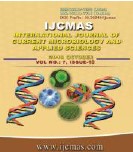


 National Academy of Agricultural Sciences (NAAS)
National Academy of Agricultural Sciences (NAAS)

|
PRINT ISSN : 2319-7692
Online ISSN : 2319-7706 Issues : 12 per year Publisher : Excellent Publishers Email : editorijcmas@gmail.com / submit@ijcmas.com Editor-in-chief: Dr.M.Prakash Index Copernicus ICV 2018: 95.39 NAAS RATING 2020: 5.38 |
Rice is an important staple food crop of the world. Aerobic rice system is a new way of growing rice that needs less water than low land rice. It is grown like an upland crop (maize, wheat, Oats etc.) in soil, which is un-puddled, non-flooded or saturated. On the basis of this fact an experiment was conducted during kharif season of 2013 and 2014 at Rice Research Station, Bankura, West Bengal, India. The soil of experimental field was sandy loam in texture with medium in fertility status. This experiment was laid out in a split-plot design (SPD) with three replications and compared two factors (4 rice varieties and 4 different seed rates) to find out the optimum seed rate for different rice varieties (HYV and hybrid) under aerobic un-puddled condition. Recommended fertilizer dose (RFD) was N, P2O5, K2O @ 80, 40, 40 kg ha-1. ZnSO4 @ 25 kg ha-1 was applied as basal. Pendimethalin (PE) @ 1.0 kg a.i. ha-1 at 1 day after sowing (DAS) and 2, 4-D Na salt (80 WP) @ 0.08 kg a.i. ha-1 at 20 DAS was applied. One hand weeding was done at 50 DAS. Direct seeding was done at row spacing of 20 cm with continuous sowing. Four rice varieties; V1 - Puspa (IET 17509), V2 - Vandana, V3 - DRRH-3 and V4 - PAC-837 were randomly allotted in the three main plots; while four levels of seed rates (S1 - 15, S2 - 25, S3 -35 and S4 - 45 kg ha1) were randomly allotted in the four sub plots of each main plot. The experimental results revealed that varieties (HYV and hybrid) and seed rates have marked influence on yield attributes and yield of aerobic rice. Aerobic rice yield increased significantly as the seed rate increased from 15 to 25 kg ha-1. There is significant increase in yield with increase in seed rate upto 25 kg ha-1. The results established that seed rate of 25 kg ha-1 was promising for realizing best aerobic rice yield. Among the varieties tested, hybrids out yielded the high yielding varieties (HYV). Hybrid rice variety DRRH-3 proved the best. The yield increase was ascribed to concomitant increase in panicle number and panicle weight. DRRH-3 has yielded highest grain yield (4.19 t /ha) in aerobic situation during kharif, 2013 and 2014.
 |
 |
 |
 |
 |